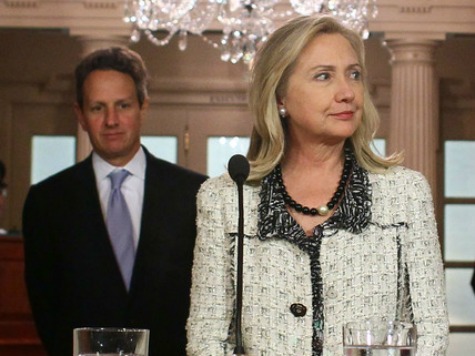WASHINGTON (AP) — Timothy Geithner says in a new memoir that he considered stepping down as Treasury secretary in 2010 after the financial crisis and suggested Hillary Rodham Clinton as a possible successor.
President Barack Obama rebuffed Geithner’s suggestion, and he remained at Treasury until 2013.
Geithner’s memoir will be published next week. On Thursday, The Associated Press bought an early copy.
Geithner writes of the incident in “Stress Test,” which explores his turbulent four years at Treasury. During his tenure, the Obama administration faced the worst recession and most severe financial crisis since the Great Depression.
In proposing that the White House consider Clinton as his successor, Geithner cited her star power as secretary of state. Among the other names Geithner suggested was Jack Lew, who succeeded him last year.
No Treasury secretary since the Depression confronted so many financial threats at once. When Geithner became Treasury secretary in January 2009, the economy had sunk into a deep recession. Unemployment was surging, and the financial system was teetering.
Having previously led the Federal Reserve Bank of New York, Geithner had worked to craft the government’s early response to the financial crisis. The crisis erupted in the fall of 2008 with the fall of investment bank Lehman Brothers and the government takeover of mortgage giants Fannie Mae and Freddie Mac
Geithner’s supporters said he deserved credit for helping steady the banking system, restore investor confidence and avert a complete meltdown.
His critics countered that Geithner’s policies consistently favored big banks and neglected ordinary Americans, including many struggling to save their homes after a wave of foreclosures followed the housing bust.
In his memoir, Geithner pushes back against such criticism. He writes that it would have been impossible to fix the economy without first shoring up the banking system and restoring confidence. This, he writes, was the most urgent task. A banking panic would have defeated the administration’s efforts to help the economy recover.
He acknowledges that the government’s efforts to help troubled homeowners keep their homes were inadequate. But he argues that no “game-changing housing plan” that would have offered Americans substantial relief existed for Geithner’s team to embrace.
Geithner rejected the idea of fixing banks by nationalizing them or letting the weakest firms fail. Instead, he writes, while vacationing on a beach in Mexico, he fleshed out a plan for using “stress tests” to see how much additional capital banks would need to survive a financial catastrophe.
If banks struggled to pass these tests, they would have to raise capital privately or be forced to accept support from the government. Geithner writes that this strategic choice was key to salvaging the financial system.
In the book, Geithner addresses his biggest public relations disaster — his first speech as Treasury secretary on Feb. 10, 2009.
Obama had told reporters at his first news conference that Geithner would lay out how the administration would fix the financial system.
“He’s going to be terrific,” Obama said of Geithner.
The speech unnerved investors. The Dow Jones industrial average plunged nearly 400 points, an ominous start for an administration official whose main task was to restore confidence in financial markets.
“It’s fair to say the speech did not go well,” Geithner writes.
Yet Geithner said the plan, which involved determining how much capital the biggest banks needed, ended up working.

COMMENTS
Please let us know if you're having issues with commenting.